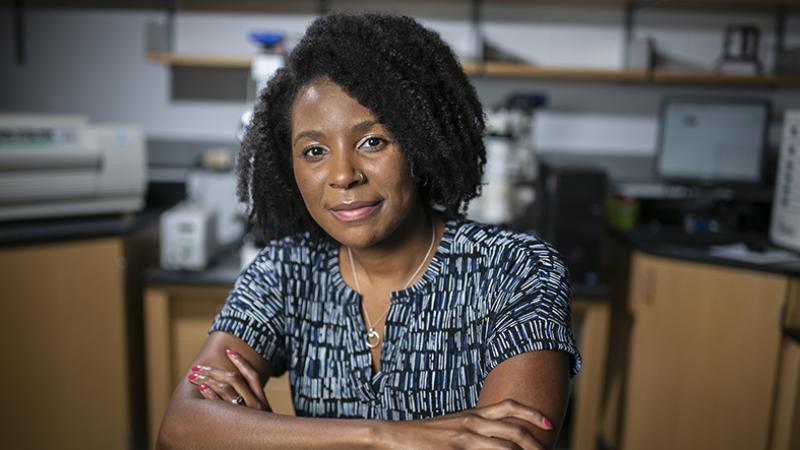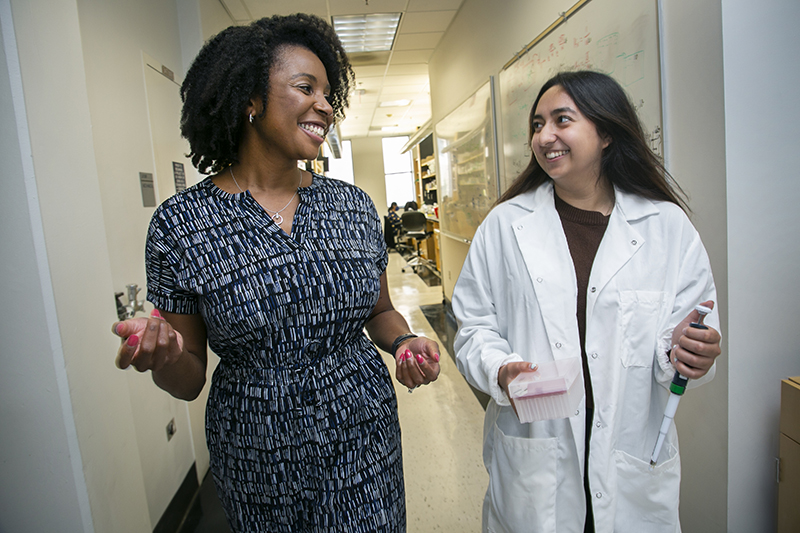
Changing the Narrative: Chantell Evans Aims to Set an Example
Growing up in a small, predominantly white town in central Illinois in the 1990s, Chantell Evans, PhD, didn’t know a lot of Black women like herself who aspired to become scientists. But her mother encouraged her to pursue her interest in math and science, and to chase after her dreams.
“From a very young age, I realized I was different from the other kids,” said Evans, assistant professor in the Department of Cell Biology and a Duke Science and Technology Scholar in the School of Medicine. “My mom always tried to put a positive spin on it, encouraging me to stand out in school and in sports, and I just took that encouragement and wholeheartedly ran with it.”
Her achievements in high school earned her the Gates Millennium Scholarship, a grant funded by the Bill & Melinda Gates Foundation that provides outstanding minority students from disadvantaged backgrounds with financial support to pursue an undergraduate degree in any discipline of interest.
Evans chose to study chemistry at Southern Illinois University in Carbondale. She participated in a National Science Foundation-funded research experiences for undergraduates (REU) in which she investigated the chemical make-up and energy transfer of polymers used for chemical and biological sensors.
Dipping her toes in research made her want to jump into the deep end, leading her to pursue a PhD in molecular and cellular pharmacology at the University of Wisconsin-Madison. “It was a good fit for me because I could apply my chemistry background to biological problems and questions,” said Evans.
Building A Career Around Brain Chemistry
For her PhD research, Evans accepted a position in the lab of Ed Chapman, PhD, Ricardo Miledi Professor of Neuroscience at the University of Wisconsin-Madison. Evans was delighted by her experiences learning to apply her background to study brain communication in the Chapman lab. Specifically, she researched how synaptic vesicles, tiny sacs found in nerve cells in the body, release neurotransmitters, the chemical molecules that jump from one neuron to the next and allow the nervous system to communicate.
Evans loved the work, but at the end of her PhD she wasn’t sure if there was a place for her in academia.
“While I received a lot of support from my mentors, the composition of the faculty was predominantly men with very few women in general and pretty much no women of color,” she said. “That led me to wonder if people who look like me had a place in academia. But my advisor was really encouraging, and he said, ‘You can totally do this,’ and that gave me the confidence I needed to continue to move on.”
Evans’ next step was a postdoctoral research position at the University of Pennsylvania’s Perelman School of Medicine, in the lab of Erika Holzbaur, PhD, William Maul Measey Endowed Professor, where she gained experience in live cell imaging. Using this technique, she imaged the cellular makeup of nerve cells. That’s where she stumbled upon mitochondria, the most beautiful and spellbinding organelles she had ever come across.
“Mitochondria are incredibly interesting organelles and are so beautiful to image,” said Evans. “They're highly dynamic in the cell. They're constantly fusing together and then breaking apart. They contain their own DNA and are really cool organelles. For a long time, the focus has been on ATP (adenosine triphosphate) generation, but mitochondria do so much more than that, and they’re finally getting the limelight.”
Humans are born with all the nerve cells they will ever have, explained Evans, and in each of those nerve cells live about two million mitochondria — tiny power generators that keep the cell functioning properly. As mitochondria age or become dysfunctional, the cell systematically removes them and replaces them with newer models.
Evans began to ask questions like, “How does the cell know how to maintain all of those mitochondria? How does it keep track of who is healthy, who’s damaged, who needs to be replaced, and how many new mitochondria need to be made?”
Understanding the elaborate system is important, she says, because disruptions can lead to nerve cell dysfunction and death, which contributes to neurodegenerative diseases such as Parkinson’s disease and Alzheimer’s disease.

A Commitment to Visibility
In 2017, Evans was named a Howard Hughes Medical Institute Hanna H. Gray Fellow. The goal of the fellowship program is to recruit and retain individuals from gender, racial, ethnic, and other groups underrepresented in the life sciences and to support them in their drive to become leaders in academic research. Evans joined 14 other scientists as part of the fellowship’s inaugural cohort.
“It’s really provided me with a sense of community. It is wonderful to be a part of a group of exceptional young scientists from diverse backgrounds,” said Evans. “We have really bonded and built relationships, especially during COVID. They are people that I can bounce ideas off of and talk to about the struggles that exist for us within academia.”
Evans’ positive experiences in the HHMI fellowship program, and the encouragement of other female scientists around her, including Holzbaur, led her to finally see and believe that not only did she belong in the sciences, but she was also desperately needed. She decided that going forward in her career, part of her mission would be to recruit other talented women from minority populations to academic science.
“I think it's important to continue to be visible. I almost left academia because I didn’t see people who looked like me,” she said. “There are not a lot of Black women in STEM. I'm very passionate about changing this narrative. So, being a good mentor and role model are things I take seriously.”
Evans joined Duke in September 2021, recruited with funds from The Duke Endowment to advance Duke Science and Technology, a major new initiative to elevate and sustain excellence in the sciences at Duke.
“Evans was recruited for her promising research program into how mitochondrial diversity and dynamics intersect at the molecular level with neuronal physiology and neurodegenerative diseases,” said Scott Soderling, PhD, chair of the Department of Cell Biology.
Evans’ most recent research inquiries are characterizing a novel repair mechanism for mitochondria and understanding when and where these diverse pathways are activated in the neuron. She hopes that insights into these mechanisms will be applicable to multiple neurodegenerative diseases.
Evans’ lab is currently made up of two Duke undergraduate research assistants, one research technician, and two PhD students who will rotate through the lab through May 2022, hailing from the Neurobiology and the Cell and Molecular Biology graduate programs. Evans said that key components of her mentoring approach are tailoring mentoring to everyone’s unique needs and helping students identify the research area and techniques they would like to work on within her lab’s scope.
“People feel more of a sense of ownership and work harder when they're excited about their projects,” said Evans.
She said that she came to Duke because of the research environment and the emphasis the university places on inclusive excellence. “Here, I feel like I have the opportunity to make a difference on multiple levels.”
“At some institutions, there were few women of color in senior leadership roles,” she said. “To see a school that is valuing that and putting women in senior roles said a lot about the institution. I also wanted to go somewhere where I was going to be supported and mentored as a junior faculty member. I’m excited to start my lab here at Duke and look forward to future collaborations and discoveries.”
Lindsay Key is a freelance science writer and editor specializing in human health and the environment.
Photos by Chris Hildreth/Rooster Media
